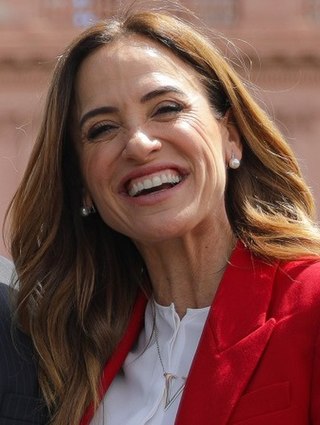
The University of Buenos Aires is a public research university in Buenos Aires, Argentina. It was established in 1821. It has educated 17 Argentine presidents, produced four of the country's five Nobel Prize laureates, and is responsible for approximately 40% of the country's research output.
Jacques de Mahieu, whose real name was Jacques Girault, was a French Argentine anthropologist and Peronist. He wrote several books on esoterism, which he mixed with anthropological theories inspired by scientific racism.

The 1943 Argentine coup d'état, also known as the Revolution of '43, was a coup d'état on 4 June 1943 that ended the government of Ramón Castillo, who had been fraudulently elected to the office of vice-president before succeeding to the presidency in 1942 as part of the period known as the Infamous Decade. The military was opposed to Governor Robustiano Patrón Costas, Castillo's hand-picked successor, a major landowner in Salta Province and a primary stockholder in the sugar industry. The only serious resistance to the military coup came from the Argentine Navy, which confronted the advancing army columns at the Navy Petty-Officers School of Mechanics.

Elisa Beatriz Bachofen was the first female civil engineer in Argentina and Latin America.

Victoria Tolosa Paz is an Argentine politician and public accountant. From 2022 to 2023, she served as Minister of Social Development in the cabinet of President Alberto Fernández. Since 2023, she has been a s a National Deputy elected in Buenos Aires Province, a position she previously held from 2021 to 2022.

Emiliano Benjamín Yacobitti is an Argentine politician. He is a member of the Radical Civic Union (UCR), and served as the Buenos Aires City UCR Committee from 2013 to 2017. From 2019 to 2023, he was a National Deputy elected in the City of Buenos Aires.

The Faculty of Social Sciences, commonly and informally known as Sociales, is the social sciences faculty of the University of Buenos Aires (UBA), the largest university in Argentina. It was founded in 1988, and offers degrees on social work, sociology, labor relations, communication and political science, in addition to a number of post-graduate degrees.

The Faculty of Medical Sciences, formerly and commonly known as the Faculty of Medicine, is the medical school of the University of Buenos Aires (UBA), the largest university in Argentina. Established in 1822 as one of the UBA's earliest divisions, FMED is presently the largest medical school in Argentina, with over 24,000 enrolled students as of 2011.

The Faculty of Architecture, Design and Urbanism is a faculty of the University of Buenos Aires (UBA), the largest university in Argentina. Established in 1901 as the School of Architecture, it has since expanded to impart courses on graphic design and urbanism.

Ciudad Universitaria is an urban campus of the University of Buenos Aires, the largest and most prestigious university in Argentina. Originally designed as a potential centralized campus for all of the university's facilities, nowadays it only houses two of its thirteen faculties: the Faculty of Architecture, Design and Urbanism and the Faculty of Exact and Natural Sciences, as well as a number of dependent institutes and a sports center.

The Faculty of Veterinary Sciences, also simply known as Veterinaria, is a faculty of the University of Buenos Aires (UBA), the largest university in Argentina. It was founded as an autonomous faculty in 1972, when it was split from the Faculty of Agronomy and Veterinary Sciences, which was originally founded in 1904 as the Instituto Superior de Agronomía y Veterinaria.

The Faculty of Economic Sciences, also simply known as Económicas, is a faculty of the University of Buenos Aires (UBA), the largest university in Argentina. Established in 1913 as the Instituto de Altos Estudios Comerciales, it is now the largest faculty within UBA, with over 36,000 grad students. The Faculty of Economic Sciences has the highest rate of international postgraduate students at 30 percent, in line with its reputation as a "top business school with significant international influence."

The Faculty of Pharmacy and Biochemistry is a faculty of the University of Buenos Aires (UBA), the largest university in Argentina. It was founded as an autonomous faculty in 1957, when it was split from the Faculty of Medical Sciences.

The Faculty of Dentistry is a faculty of the University of Buenos Aires (UBA), the largest university in Argentina.

Cine Cosmos is a restored cinema on Avenida Corrientes in Buenos Aires, Argentina. Originally inaugurated as Cine Cataluña in 1929, it became known under its current name in the 1960s for its showings of alternative Soviet cinema. Since 2010 it has been owned and operated by the University of Buenos Aires, Argentina's largest university.

The Faculty of Psychology is a faculty of the University of Buenos Aires (UBA), the largest university in Argentina. It offers graduate degrees on psychology, music therapy and vocational rehabilitation, as well as various post-graduate degrees on diverse fields.

The Faculty of Philosophy and Letters, also known as Filo, is a faculty of the University of Buenos Aires (UBA). The faculty was founded in 1896, making it one of the oldest faculties at the university. It offers graduate degrees in multiple subjects including philosophy, literature, anthropology, history, arts, education, geography, modern and classical languages, and literary editing, as well as post-graduate degrees at the magister, doctoral, and post-doctoral level.
Ricardo Jorge Gelpi is an Argentine physician and professor, and the current Rector of the University of Buenos Aires (UBA), the largest university in Argentina. Gelpi previously served as dean of the UBA Faculty of Medical Sciences.

The Faculty of Engineering is a faculty of the University of Buenos Aires (UBA), the largest university in Argentina. It offers graduate courses on various fields of engineering, including civil engineering, computer science and engineering, mechanical engineering, electronic engineering, naval engineering, among others. It also offers graduate courses on system analysis, as well as post-graduate degrees on the magister, doctoral and post-doctoral levels.


















